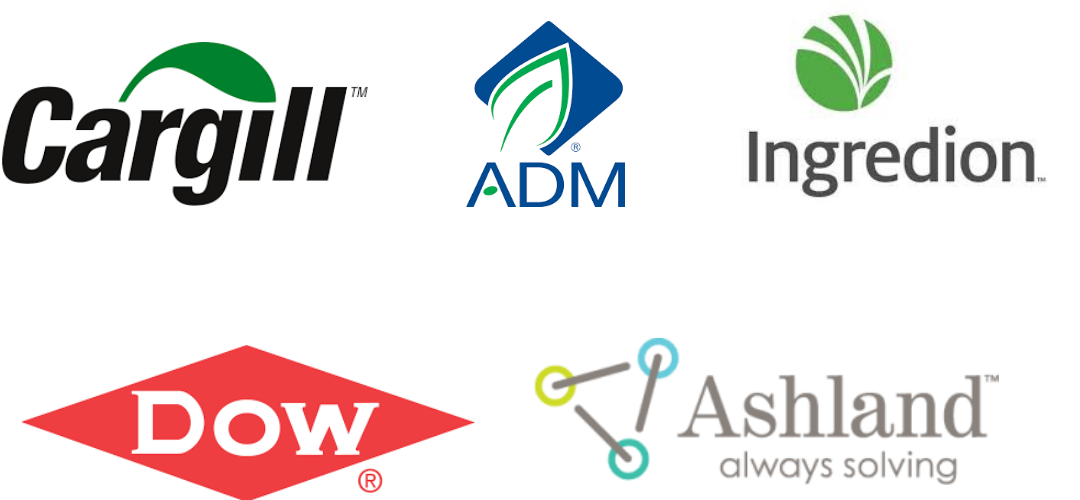Market Size of Food Thickener Industry

| Study Period | 2019 - 2029 |
| Base Year For Estimation | 2023 |
| CAGR | 6.12 % |
| Fastest Growing Market | North America |
| Largest Market | Europe |
| Market Concentration | High |
Major Players
*Disclaimer: Major Players sorted in no particular order |
Food Thickener Market Analysis
The global food thickener market is growing at a CAGR of 6.12% during the forecast period (2020-2025).
- The market is mainly driven by its extensive use in the food and beverage sector such as bakery products, confectionery products, sauces, dressings, beverages, dairy & frozen desserts, and processed food. Also, the added benefits of thickeners, such as multifunctionality, absorption of nutrients, compatibility with other ingredients, low cost, and abundant supply of food thickeners. Furthermore, advancements in the extraction and processing of food thickeners from new natural sources is thus one of the major opportunities for the researchers and the leading players competing in the global market. For instance, in June 2015, researchers at Oregon State University discovered and commercialized a new type of dairy thickener- Ropy 352, which can add probiotic characteristics to the product in which it is used.
- However stringent regulations from regulatory bodies such as Food and Drugs Organization (FDA), the European Commission (EU), the European Food Safety Authority (EFSA), Health Canada, and Food Standards Australia New Zealand (FSANZ) for the use of thickeners are expected to impede the market growth. Also, the fluctuating hydrocolloids price affects the overall food thickeners market heavily. For instance, in October 2011, Danisco announced that the global hydrocolloid price increased by 5% to 15% due to rise in raw material, energy, and logistics costs, which directly affected the overall thickener market.
Food Thickener Industry Segmentation
The global food thickener market has been segmented by category into natural and synthetic; and by type into hydrocolloids, protein and starch. The hydrocolloids segment can be further bifurcated into gelatin, xanthan gum, agar, pectin, and others. By application, the market is segmented into bakery & confectionery, dairy-based products, sauces & dressings, beverages, and others. Also, the study provides an analysis of the food thickener market in the emerging and established markets across the globe, including North America, Europe, Asia-Pacific, South America, and Middle East & Africa.
| By Category | |
| Natural | |
| Synthetic |
| By Type | |||||||
| |||||||
| Protein | |||||||
| Starch |
| By Application | |
| Bakery & Confectionery | |
| Dairy | |
| Sauces & Dressings | |
| Beverages | |
| Others |
| Geography | |||||||||
| |||||||||
| |||||||||
| |||||||||
| |||||||||
|
Food Thickener Market Size Summary
The food thickener market is experiencing significant growth, driven by its widespread application in the food and beverage industry. Thickeners are extensively used in products such as bakery items, confectionery, sauces, dressings, beverages, dairy, frozen desserts, and processed foods. Their multifunctional benefits, including nutrient absorption, ingredient compatibility, cost-effectiveness, and abundant supply, further propel market expansion. Innovations in the extraction and processing of thickeners from new natural sources present substantial opportunities for industry players. However, the market faces challenges from stringent regulations imposed by entities like the FDA and the European Commission, as well as fluctuating hydrocolloid prices, which can impact overall market dynamics.
The demand for thickening agents, particularly agar, is on the rise, especially in the bakery and confectionery sectors, due to its ability to withstand high temperatures and its tasteless nature, which does not interfere with food flavors. The Europe and Asia-Pacific regions dominate the market, driven by increased consumption of food thickeners and a focus on product innovation and health-conscious offerings. The market is characterized by fragmentation, with numerous regional and domestic players. Companies are focusing on mergers, expansions, acquisitions, and partnerships, alongside new product development, to enhance their market presence.
Food Thickener Market Size - Table of Contents
-
1. MARKET DYNAMICS
-
1.1 Market Drivers
-
1.2 Market Restraints
-
1.3 Porter's Five Forces Analysis
-
1.3.1 Threat of New Entrants
-
1.3.2 Bargaining Power of Buyers/Consumers
-
1.3.3 Bargaining Power of Suppliers
-
1.3.4 Threat of Substitute Products
-
1.3.5 Intensity of Competitive Rivalry
-
-
-
2. MARKET SEGMENTATION
-
2.1 By Category
-
2.1.1 Natural
-
2.1.2 Synthetic
-
-
2.2 By Type
-
2.2.1 Hydrocolloids
-
2.2.1.1 Gelatin
-
2.2.1.2 Xanthan Gum
-
2.2.1.3 Agar
-
2.2.1.4 Pectin
-
2.2.1.5 Others
-
-
2.2.2 Protein
-
2.2.3 Starch
-
-
2.3 By Application
-
2.3.1 Bakery & Confectionery
-
2.3.2 Dairy
-
2.3.3 Sauces & Dressings
-
2.3.4 Beverages
-
2.3.5 Others
-
-
2.4 Geography
-
2.4.1 North America
-
2.4.1.1 United States
-
2.4.1.2 Canada
-
2.4.1.3 Mexico
-
2.4.1.4 Rest of North America
-
-
2.4.2 Europe
-
2.4.2.1 Spain
-
2.4.2.2 United Kingdom
-
2.4.2.3 Germany
-
2.4.2.4 France
-
2.4.2.5 Italy
-
2.4.2.6 Russia
-
2.4.2.7 Rest of Europe
-
-
2.4.3 Asia Pacific
-
2.4.3.1 China
-
2.4.3.2 Japan
-
2.4.3.3 India
-
2.4.3.4 Australia
-
2.4.3.5 Rest of Asia-Pacific
-
-
2.4.4 South America
-
2.4.4.1 Brazil
-
2.4.4.2 Argentina
-
2.4.4.3 Rest of South America
-
-
2.4.5 Middle East and Africa
-
2.4.5.1 South Africa
-
2.4.5.2 Saudi Arabia
-
2.4.5.3 Rest of Middle East and Africa
-
-
-
Food Thickener Market Size FAQs
What is the current Food Thickener Market size?
The Food Thickener Market is projected to register a CAGR of 6.12% during the forecast period (2024-2029)
Who are the key players in Food Thickener Market?
Cargill, Incorporated, Archer Daniels Midland Company, Ingredion Incorporated, Ashland Global Holdings Inc. and Dupont are the major companies operating in the Food Thickener Market.

